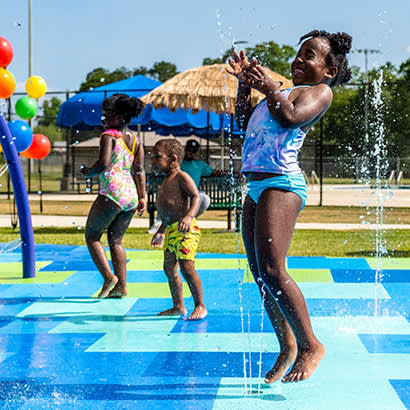
For an enhanced digital experience, read this story in the ezine.
Everyone experiences play in different ways — it’s the reason why there isn’t just one type of spray feature or one type of pool. Age, ability and even personal preference all contribute to how someone engages within a space and with other people. Accounting for these differences helps to create an inclusive and inviting environment.
There are many different kinds of play. Collaborative, imaginative and multigenerational play can foster important skills needed for childhood development. When these types of play are paired with water activities found in areas like splash pads, risky play — the positive kind — is introduced and children often gain more confidence around water while playing. Positive experiences around water create good introductions and lead to developing valuable lifelong skills, such as swimming.
Designing Play Spaces
When planning for these different kinds of play, balance is important to ensure everyone can engage safely and comfortably. This can be achieved through zoning, which is a great way to improve inclusivity for different developmental age and ability groups. Zoning is achieved by placing spray features and toys in strategic areas where individuals can self-select where they want to play without fearing unexpected or unwanted situations. For example, a parent and a small toddler may prefer a quiet area with small floor-jet sprays while older children may want to stand under dump buckets and spray one another with dueling jets. Surfacing can help guests visually distinguish areas by color or pattern and can be an easy way for caregivers to help children stay within a certain zone.
Play value directly influences visitor perception of a facility and can be a determining factor of whether or not they will return. People often think of spray features when they visualize aquatics play, but the surface itself is a feature and often covers 50 to 90 percent of an aquatics amenity. Many facilities use concrete, but the possibilities this otherwise blank canvas offers are limitless. When surfaces are designed intentionally, they become the largest features with the highest engagement rate. Everyone touches the floor, and the imagery can include theming, characters, games and pathways that encourage full activation around the space. Safety surfaces that are certified to NSF/ANSI/CAN 50 can go even further to promote play with cushioned and slip-resistant attributes that reduce injuries and create a fun, inviting environment.
Welcoming All
When evaluating accessible spaces, it can be helpful to imagine yourself in different scenarios and engage with your facility from another perspective, such as riding a wheelchair or using forearm crutches. From the parking lot to the amenity itself, there are numerous touchpoint opportunities that can be considered to create an inclusive and inviting guest experience along the way.
It can seem overwhelming to consider all the options, but the easiest way to begin this process is to talk to a wide range of community members and understand how they use existing facilities and what they want to see for future additions. Collect this data in different ways since not everyone has internet access to fill out an online survey, and some people may be unable to attend an in-person meeting.
Planning with accessibility in mind will make a wider range of guests feel more welcome, creating opportunities for longer and more frequent visits full of fun!
Briana Valente is Marketing Manager at Life Floor.

